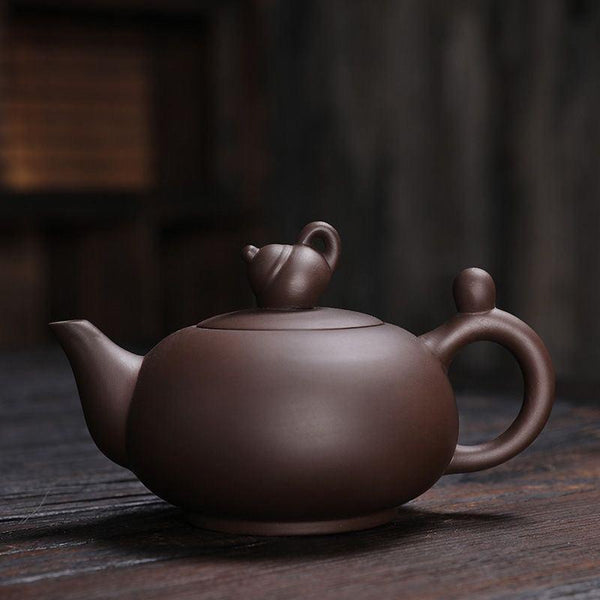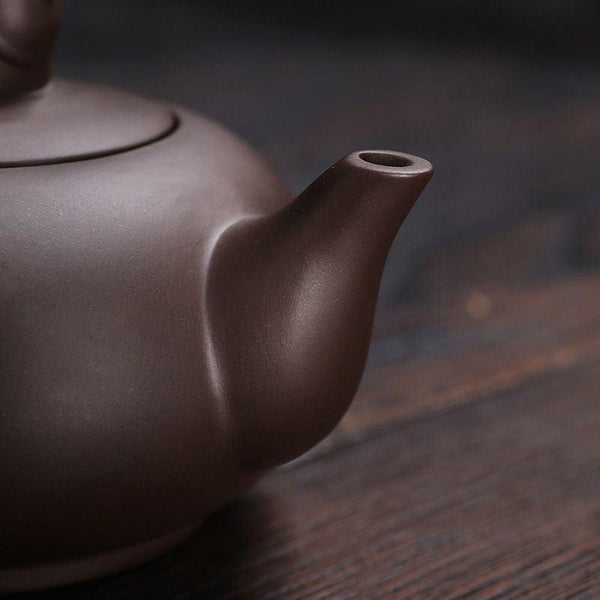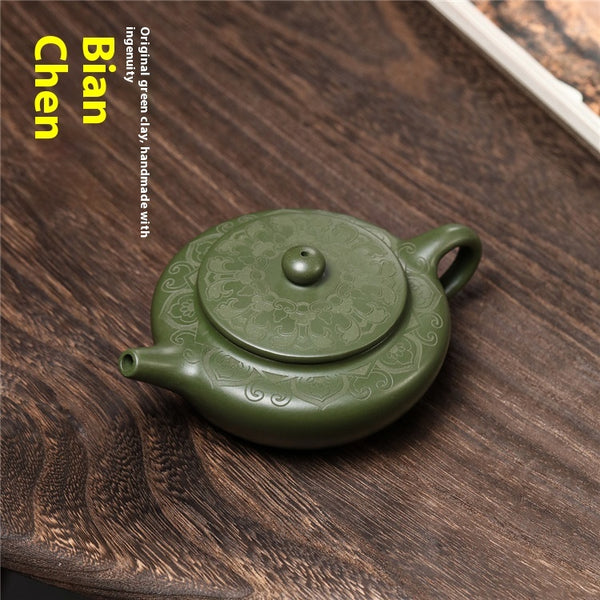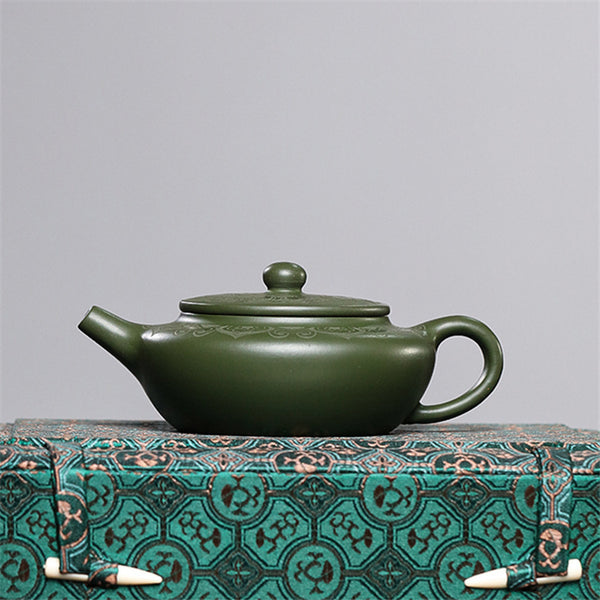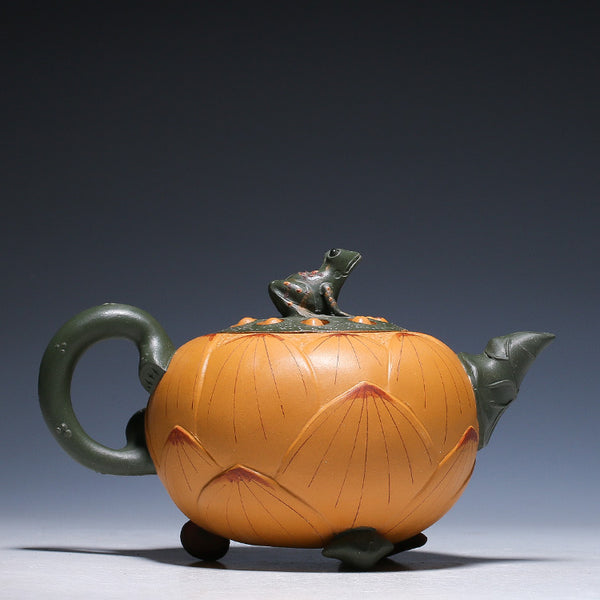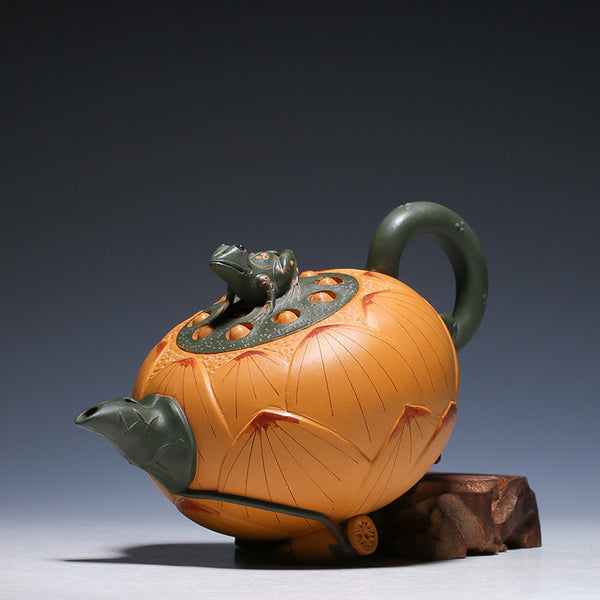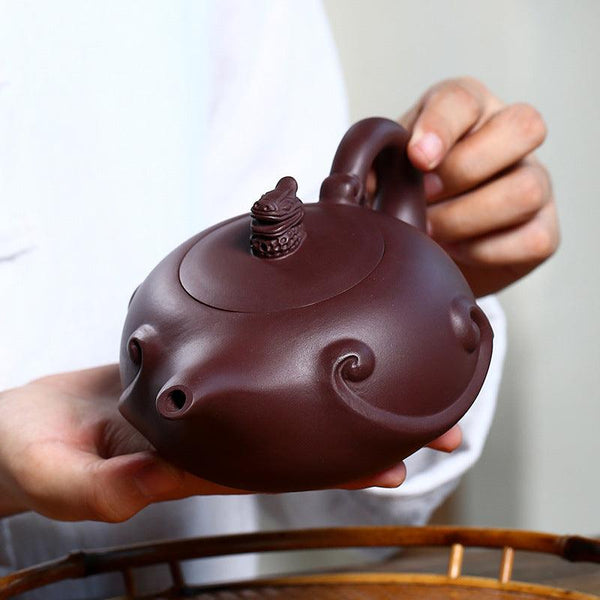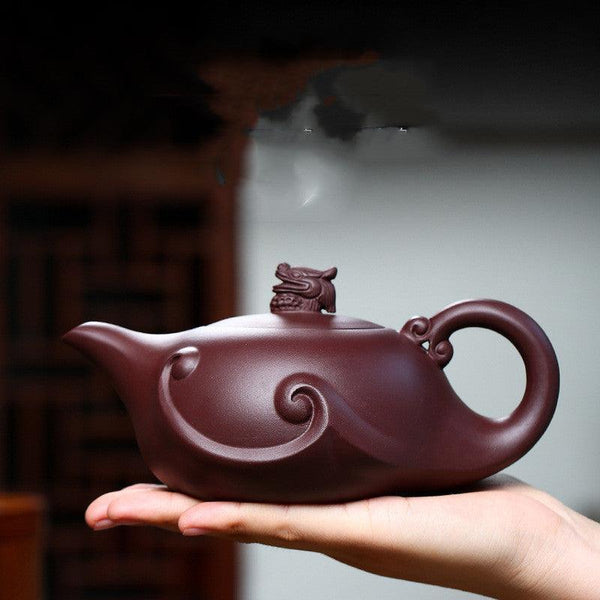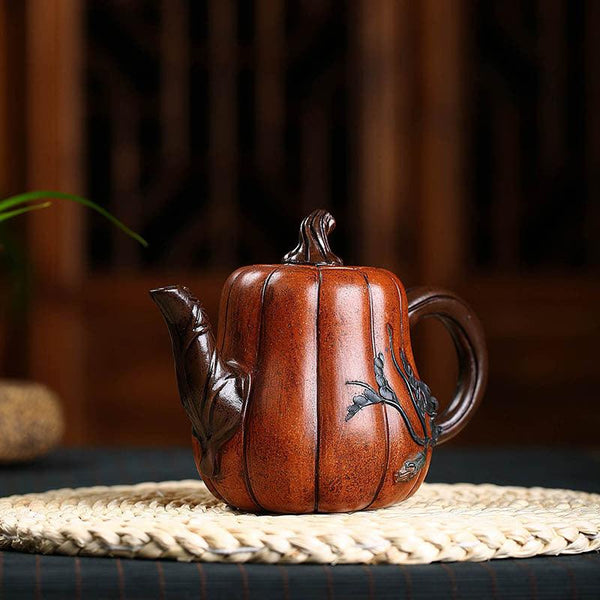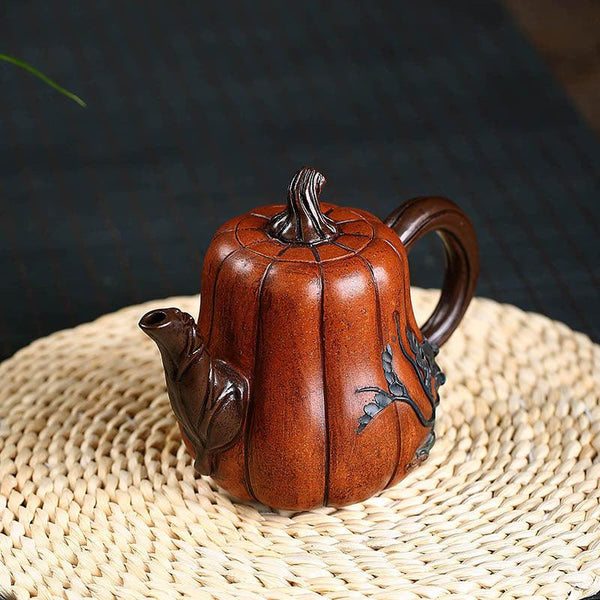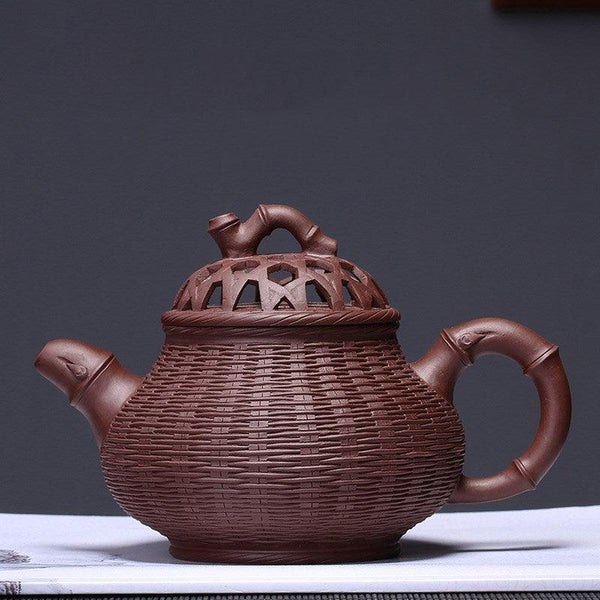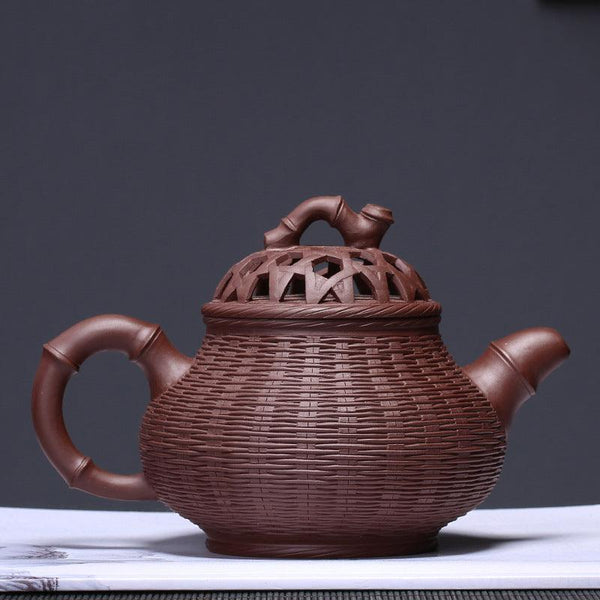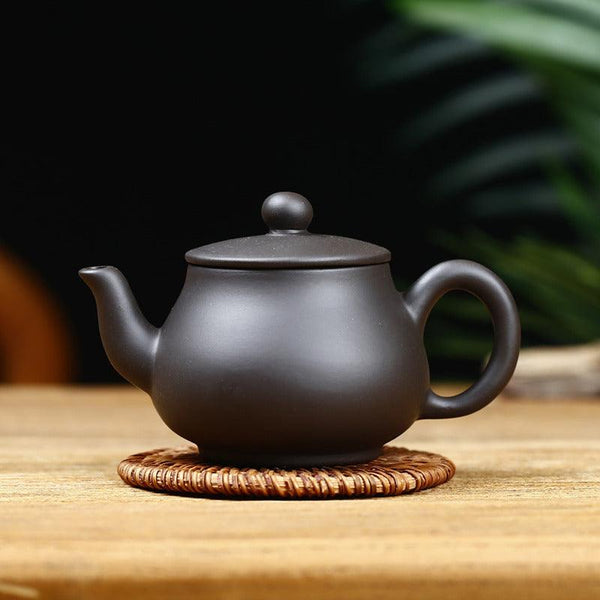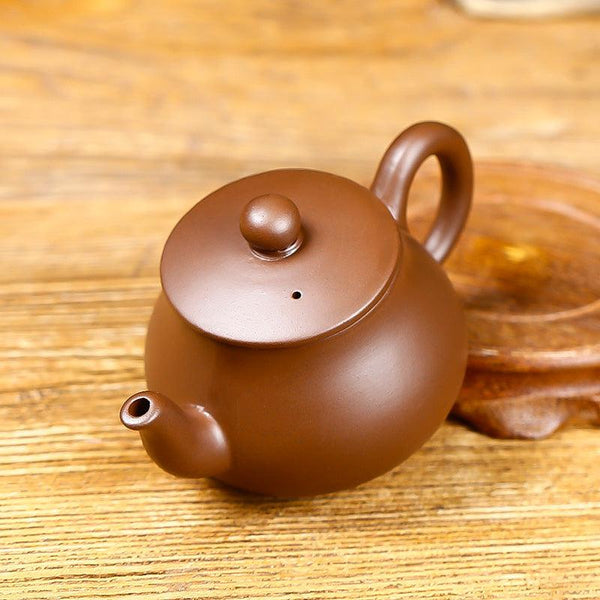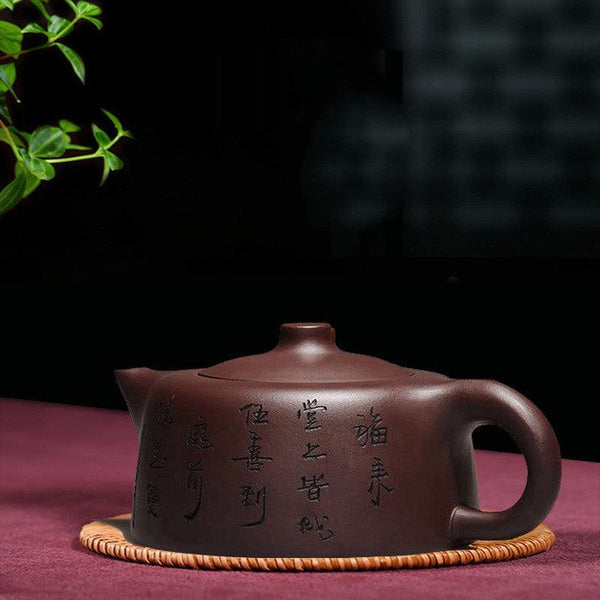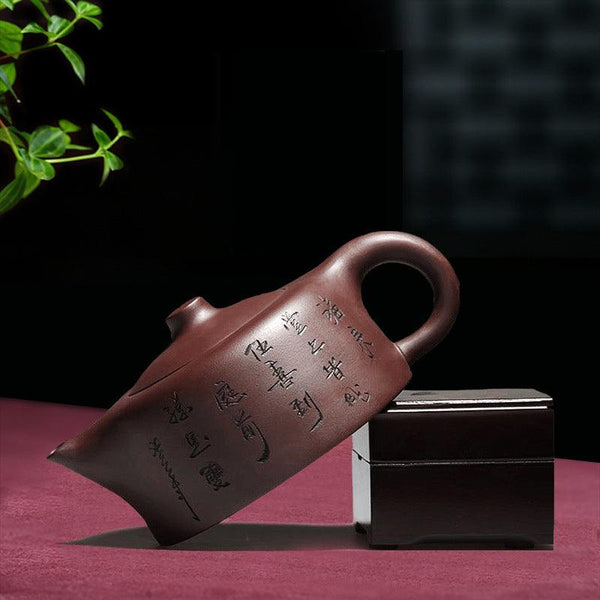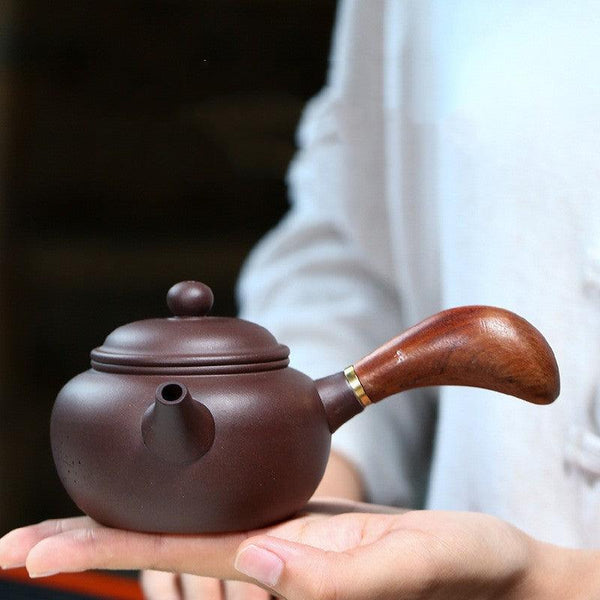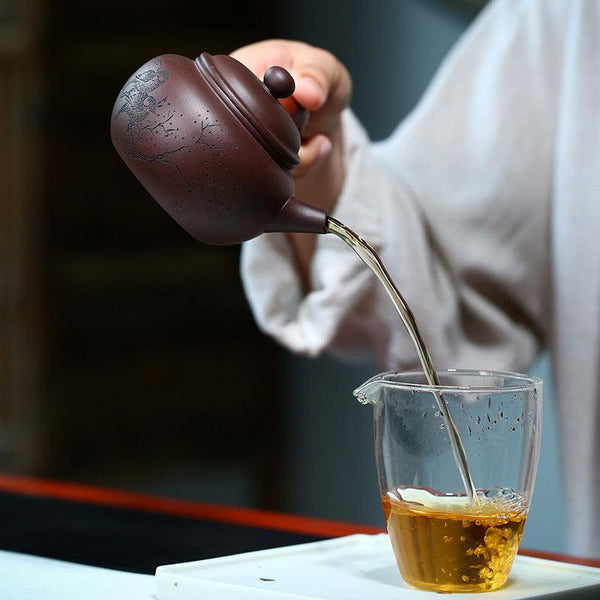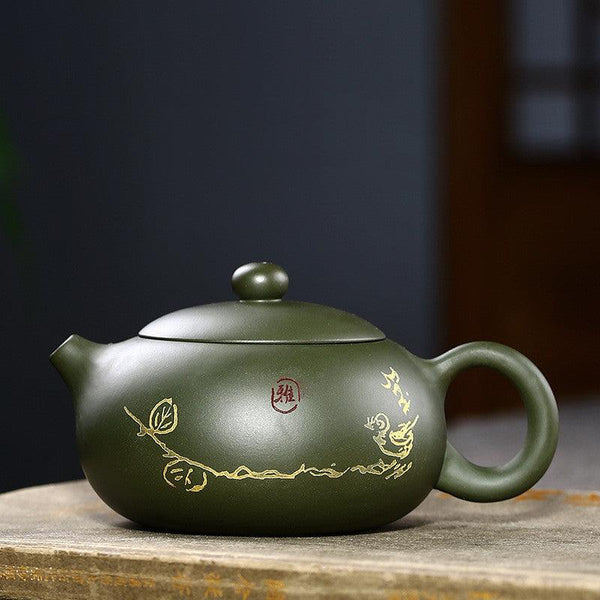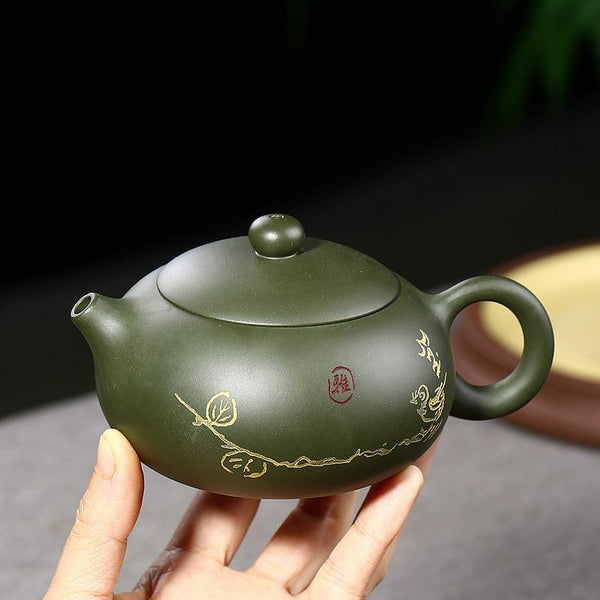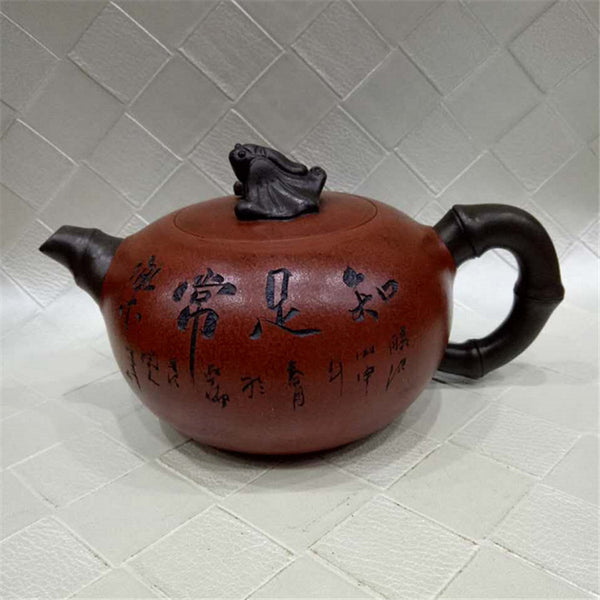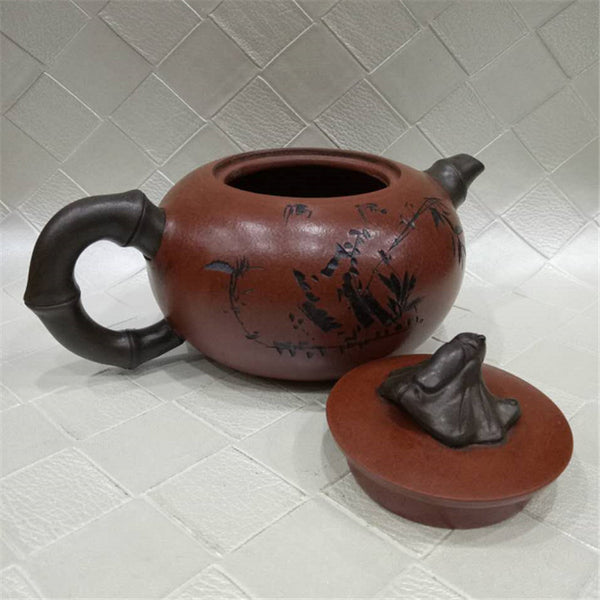In the world of tea, the zisha teapot shines like a brilliant pearl, exuding unique charm. It is not only a practical utensil for making tea but also a treasure carrying history, culture, and art. Whether you are a seasoned tea connoisseur or a novice enthusiast of tea culture, you likely desire to own a high-quality zisha teapot. But how exactly can we pick a zisha teapot that satisfies our hearts? Let's explore this in depth.
1.0 About Zisha Teapots

1.1 History and Cultural Background

1.1.1 Origin and Development:
The history of zisha teapots can be traced back to the Zhengde period of the Ming Dynasty, created by Gong Chun. Since then, zisha teapots have gradually occupied an important position in tea culture with their unique materials and exquisite craftsmanship. After hundreds of years of inheritance and development, the production techniques of zisha teapots have continuously innovated, and the shapes have become increasingly diverse.

1.1.2 Important Position in Tea Culture:
In Chinese tea culture, zisha teapots are hailed as the "king of tea sets." Their unique materials can maintain the original flavor and aroma of tea leaves, making the tea soup more mellow. At the same time, the shapes and decorations of zisha teapots often contain profound cultural connotations, complementing tea culture.
1.2 Types and Characteristics of Zisha Clay
1.2.1 Introduction of Common Clays such as Purple Clay, Red Clay, and Duan Ni:

Purple Clay:
Purple clay is one of the most common materials for zisha teapots. It is purple, purplish-red, or dark brown in color, with a fine texture and good air permeability. Purple clay has strong plasticity and is suitable for making teapots of various shapes. Teapots made of purple clay are suitable for brewing all kinds of tea, especially Pu'er tea, dark tea, and oolong tea. It can make the tea soup more mellow and the aroma more intense.

Red Clay:
Red clay has a bright color, ranging from red to dark red. Red clay has a high degree of crystallization and relatively weak air permeability. Due to its large shrinkage rate, making red clay teapots is more difficult, so red clay teapots are usually small and exquisite. Red clay teapots are suitable for brewing high-aroma teas such as Tieguanyin and Taiwan high mountain tea. It can better highlight the aroma of tea leaves and make the tea soup more refreshing and pleasant.

Duan Ni:
Duan Ni has relatively rich colors, including yellow, green, and white. Duan Ni has good air permeability and a relatively tender texture. The appearance of Duan Ni teapots is fresh and elegant, giving people a natural aesthetic feeling. Duan Ni teapots are suitable for brewing light teas such as green tea, white tea, and yellow tea. It can maintain the original flavor of tea leaves and make the tea soup more clear and bright.
1.2.2 Quality and Composition of Zisha Clay
High-quality zisha clay should have the following characteristics:
Natural Color:
The color of zisha clay should be natural and pure, without obvious traces of chemical pigments. Different zisha clays have their specific color ranges, such as purple for purple clay, red for red clay, and yellow for Duan Ni.
Good Air Permeability:
Zisha clay has a unique double-pore structure and good air permeability. This enables zisha teapots to maintain the freshness of tea leaves and make the tea soup more mellow.
Moderate Water Absorption:
Zisha clay has a certain degree of water absorption but not too strong. Moderate water absorption can make the pot body maintain a warm feel and also help improve the taste of tea.
Rich in Components:
Zisha clay is mainly composed of minerals such as quartz, mica, and clay, rich in elements such as iron, silicon, and aluminum. These components endow zisha teapots with unique physical properties and artistic charm.
1.2.3 Suitable Tea Types for Different Clays
Different zisha clays are suitable for brewing different types of tea because their characteristics such as air permeability and water absorption are different, which will affect the taste and aroma of tea.

For example, purple clay is suitable for brewing Pu'er tea, dark tea, oolong tea, etc.;
Red clay is suitable for brewing Tieguanyin, Taiwan high mountain tea, etc.;
Duan Ni is suitable for brewing green tea, white tea, yellow tea, etc.
1.3 Production Techniques of Zisha Teapots
1.3.1 Differences between Fully Handmade, Semi-Handmade, and Machine-Made Teapots:
Fully Handmade:
Fully handmade zisha teapots are completed entirely by potters relying on handicraft skills. From beating the clay sheet, wrapping the body cylinder, to making the spout and handle, and engraving, every step is infused with the potter's efforts and wisdom. Fully handmade teapots have exquisite craftsmanship, beautiful shapes, and high artistic value. Each fully handmade teapot is a unique work of art, and its value is relatively high.
Semi-Handmade:
Semi-handmade teapots use molds in some steps but still retain some handicraft techniques. For example, when making the body cylinder, molds can be used to ensure regular shapes, but parts such as the spout, handle, and lid are still made by hand. Semi-handmade teapots also have certain guarantees in appearance and quality, and the price is relatively more affordable than fully handmade teapots.
Machine-Made:
Machine-made teapots are mass-produced by machines. This production method is efficient but relatively crude in craftsmanship and lacks the charm of handmade products. Machine-made teapots have a lower price but also relatively lower quality and artistic value.
1.3.2 Impact of Craftsmanship on Teapot Quality
Production techniques directly affect the quality of zisha teapots. Fully handmade teapots have exquisite craftsmanship, beautiful shapes, and high artistic value. Semi-handmade teapots also have certain guarantees in appearance and quality. While machine-made teapots have relatively lower quality and may have some flaws. In addition, craftsmanship also affects the teapot's properties such as air permeability and water absorption. Fine production techniques can make the pores of the teapot more uniform, thereby improving its air permeability and water absorption.
1.4 Shapes of Zisha Teapots
Zisha teapots come in a rich variety of shapes, including round, square, and biomorphic shapes. Different shapes not only have different aesthetic values but also affect the brewing effect of tea.

Round Teapots:
Round teapots have a round and full shape, giving people a sense of stability and grandeur. The internal space of round teapots is relatively large, suitable for brewing teas with a high degree of fermentation, such as Pu'er tea and dark tea.

Square Teapots:
Square teapots have straight lines and a simple and atmospheric aesthetic. The internal space of square teapots is relatively small, suitable for brewing fragrant teas such as green tea and white tea.

Biomorphic teapots imitate animals and plants in nature, such as pumpkin teapots and bamboo joint teapots. Biomorphic teapots have unique artistic charm and give people a natural and friendly feeling.
1.5 Common Sizes of Zisha Teapots and Suitable Number of People

The size of zisha teapots is usually measured by capacity and is generally divided into small teapots (below 200cc), medium teapots (200cc - 350cc), and large teapots (above 350cc).
Small Teapots:
Small teapots are suitable for 1 - 2 people to drink. They are small and portable, suitable for use in offices, during travel, and other occasions.
Medium Teapots:
Medium teapots are suitable for 3 - 4 people to drink and are a common size for home use.
Large Teapots:
Large teapots are suitable for large families or more people to use and usually appear in teahouses and tea art performances.
2.0 Determining Purchase Needs
2.1 For Personal Use or as a Gift

2.1.1 Selection Points for Different Purposes:
For Personal Use:
If for personal use, choose a zisha teapot according to your own tea-drinking habits, favorite tea types, and usage scenarios. Firstly, consider the types of tea you often drink and choose the appropriate clay and pot shape. For example, people who like Pu'er tea can choose a purple clay teapot; people who like Tieguanyin can choose a red clay teapot. Secondly, consider the usage scenario. If you often use it in the office, you can choose a small and portable small teapot; if you use it at home, you can choose a medium or large teapot with a slightly larger capacity and beautiful shape. Finally, choose teapots of different crafts according to your budget. If you have a higher budget, you can choose a fully handmade teapot; if your budget is limited, a semi-handmade teapot is also a good choice.
As a Gift:
If for giving as a gift, consider the identity, preferences, and usage needs of the recipient. For elders, you can choose traditional shapes and exquisitely crafted teapots, such as classic pot shapes made of purple clay or red clay. Such teapots are both practical and have cultural connotations, able to express respect and blessings for elders. For young people, you can choose teapots with novel and fashionable shapes, such as creative pot shapes made of Duan Ni. Such teapots are more in line with the aesthetic needs of young people and can let them feel the unique charm of zisha teapots. For business gifts, you can choose masterpieces or teapots with collection value. Such teapots not only have high artistic value but also reflect the taste and sincerity of the giver.
2.1.2 Considering the Recipient's Preferences and Needs
Before giving a gift, it is best to understand the recipient's tea-drinking habits and preferences. If the recipient likes black tea, you can choose a teapot made of red clay or red mud; if the recipient likes green tea, you can choose a teapot made of Duan Ni. In addition, you can also choose the shape and decoration of the teapot according to the recipient's occupation, personality, and other factors. For example, for literati and refined scholars, you can choose a teapot engraved with poems, calligraphy, and paintings; for business people, you can choose a teapot with a simple and atmospheric shape.
2.2 Types of Tea Commonly Drunk

Different teas are suitable for different zisha clays and pot shapes. Therefore, when choosing a zisha teapot, choose according to the types of tea you often drink.
Pu'er Tea:
Pu'er tea is suitable for teapots made of purple clay. Purple clay has good air permeability and can better show the mellow taste of Pu'er tea. At the same time, the capacity of purple clay teapots can be slightly larger to better brew Pu'er tea.
Tieguanyin:
Tieguanyin is suitable for teapots made of red clay. Red clay has a high degree of crystallization and can better highlight the orchid fragrance of Tieguanyin. Red clay teapots are usually small and exquisite, suitable for brewing high-aroma teas.
Green Tea:
Green tea is suitable for teapots made of Duan Ni. Duan Ni has good air permeability and can maintain the original flavor of green tea. The color of Duan Ni teapots is fresh and elegant, complementing the color of green tea.
Black Tea:
Black tea is suitable for teapots made of red clay or red mud. The colors of red clay and red mud are bright and can echo the color of black tea. At the same time, they have better heat preservation properties and can make the tea soup of black tea more ruddy.
2.3 Usage Scenarios

Office
Teapots used in the office should choose pot shapes that are small, portable, and easy to clean. You can choose small teapots with a capacity of less than 200cc or teapots with filters for convenient brewing and cleaning. In addition, office teapots can choose styles that are simple and generous in shape and avoid overly fancy decorations to avoid affecting the work atmosphere.
Home
Teapots used at home can choose pot shapes with a slightly larger capacity and beautiful appearance. You can choose the shape and decoration of the teapot according to the home decoration style and personal preferences. If there are guests visiting, you can also choose a set of exquisite zisha tea sets to add to the tea-tasting atmosphere.
Teahouse
Teapots used in teahouses usually have a larger capacity to meet the needs of more people. Teahouse teapots can choose traditional shapes and exquisitely crafted styles to reflect the cultural atmosphere of the teahouse.
3.0 Selecting Zisha Teapots
3.1 Appearance Inspection

3.1.1 Whether the Shape is Regular and the Lines are Smooth
A high-quality zisha teapot should have a regular shape and smooth lines. The proportions of the pot body, lid, spout, and handle should be coordinated, without obvious flaws or deformations. You can observe the teapot from different angles to check whether its overall shape is beautiful. At the same time, pay attention to whether the connection between the spout, handle, and pot body is natural and without a sense of stiffness.
3.1.2 Check for Flaws, Cracks, and Other Issues
Carefully inspect the surface, pot body, lid, spout, and handle of the teapot to ensure there are no flaws, cracks, or hidden hairline cracks. These flaws will not only affect the beauty of the teapot but may also cause leakage or affect its structural stability during use. You can gently touch the surface of the teapot with your hand to feel if there are any uneven areas.
3.1.3 Whether the Color is Natural and Uniform
High-quality zisha teapots should have a natural and uniform color without obvious traces of chemical pigments. Different zisha clays have their specific color ranges. You should choose teapots with pure colors that conform to the characteristics of the clay. You can place the teapot under natural light to observe its color and avoid observing under strong or colored lights to avoid affecting judgment.
3.2 Hand Feel Experience
3.2.1 Touch the Smoothness and Fineness of the Teapot Surface
Touch the surface of the teapot with your hand to feel its smoothness and fineness. High-quality zisha teapots should have a smooth and fine surface without obvious graininess or roughness. At the same time, the surface of the teapot should have a certain warm feeling, giving people a comfortable touch. You can gently stroke the surface of the teapot with your fingers to feel its texture.
3.2.2 Tap the Teapot to Judge Quality by Sound
Gently tap the teapot and listen to whether the sound is clear and pleasant. If the sound is dull, there may be quality issues; if the sound is clear, it indicates that the teapot has a better texture. However, it should be noted that the tapping sound can only be used as a reference and cannot completely judge the quality of the teapot. Because different clays, pot shapes, and firing processes will affect the sound of the teapot.
3.2.3 Check Whether the Fit Between the Lid and Pot Body is Tight
The fit between the lid and pot body should be tight, and it should rotate smoothly. You can fill the teapot with water and then invert it to check whether the lid will fall off. At the same time, you can gently rotate the lid to feel whether the fit with the pot body is tight.
3.3 Process Details
3.3.1 Whether the Design of the Spout and Handle is Reasonable
The shape and angle of the spout should be designed reasonably to ensure that the tea soup can flow out smoothly without clogging or poor flow. The spout outlet should be smooth and flat without burrs. The design of the handle should conform to ergonomics, be comfortable to hold, and easy to operate. The thickness and length of the handle should be moderate and coordinated with the proportion of the pot body.
3.3.2 Check Whether the Water Flow is Smooth
Fill the teapot with water and then pour it out to observe whether the tea soup flows out smoothly. If the water flow is not smooth, it may be due to an unreasonable design of the spout or blockages inside. You can use a toothpick or thin wire to clean the inside of the spout to ensure it is unobstructed. At the same time, pay attention to whether the water column is round and uniform.
3.3.3 How is the Sealing of the Lid
Check the sealing of the lid. You can fill the teapot with water and then invert it to observe whether the lid will leak. At the same time, you can gently rotate the lid to feel whether the fit with the pot body is tight and whether there is any looseness.
3.3.4 Understand the Production Background and Author of the Teapot
If you are buying a masterpiece by a famous artist or a teapot with collection value, you can understand the production background and author of the teapot. Understanding the author's creative style, craftsmanship level, and reputation can better judge the value and quality of the teapot.
4.0 Purchase Precautions Checklist
5.0 Pot Opening and Maintenance
5.1 Pot Opening Method for New Teapots
Rinsing:
After getting the zisha teapot, first clean the inside and outside of the teapot with tap water, especially the inner wall and the water outlet hole. This step can remove the dust and impurities that may remain during the production and transportation of the teapot.
Boiling:
Pour boiling water into the teapot until it overflows, cover the lid, and then continue to rinse the surface of the zisha teapot with boiling water. Repeat this step two to three times. This can make the teapot gradually adapt to the high-temperature environment and also remove some odors.
Awakening:
Separate the lid and body of the zisha teapot and put them in a pot. Add purified water and boil it. Then simmer for about 30 minutes. It should be noted that the boiled zisha teapot must not be directly rinsed with cold water. This step can further remove the "fire" of the teapot and make it more moist.
Moisturizing:
Put a large amount of tea leaves into the awakened zisha teapot, then pour in boiling water, and finally cover the lid and let it stand for 3 - 5 hours. This step can allow the teapot to absorb the aroma of tea leaves and also make the pores of the teapot more unobstructed.
Air Drying:
Clean the processed zisha teapot again with purified water, then gently wipe it with a dry cloth. Finally, follow the simple pot opening method for the last treatment to complete the entire pot opening process of the zisha teapot.
5.2 Daily Maintenance Skills
5.2.1 How to Use and Clean Zisha Teapots Correctly:
Correct Use:
When using a zisha teapot, handle it with care and avoid collisions and drops. After each use, clean the teapot in time to avoid the accumulation of tea stains. It is best to use different teapots for different teas to avoid the flavors of different teas affecting each other. At the same time, pay attention to the maintenance of the teapot and regularly nourish the teapot with tea juice to make it more moist.
Cleaning Method:
You can rinse the teapot with clean water and then dry it with a clean soft cloth. If there is tea scale inside the teapot, you can dip a small amount of toothpaste with a soft-bristled toothbrush and gently scrub it, then rinse it with clean water. Do not clean the teapot with chemical detergents such as dishwashing liquid to avoid damage to the teapot. At the same time, avoid soaking the teapot in water for a long time or exposing it to the sun to avoid affecting the quality and service life of the teapot.
5.2.2 Methods to Avoid Damaging the Teapot:
Handle with Care:
The zisha teapot is relatively fragile in texture. During use and storage, handle it with care and avoid collisions with hard objects. You can place some soft items such as sponges and cloth around the teapot to prevent it from being impacted in case of accidents.
Avoid Sudden Changes in Temperature:
Do not put a teapot that has just been brewed with hot water directly into cold water, nor use hot water to brew a cold teapot directly. This sudden change in temperature can easily cause the teapot to crack. During use, let the teapot gradually adapt to temperature changes.
Regular Inspection:
Regularly check the surface, lid, spout, and handle of the teapot to see if there are cracks, flaws, or loose parts. If problems are found, deal with them in time to avoid aggravation.
Correct Storage:
When not using the teapot, store it in a dry and ventilated place. You can wrap the teapot with a soft cloth to avoid dust and debris pollution. At the same time, avoid placing the teapot together with other hard objects to avoid collisions.
6.0 Conclusion
Selecting a high-quality zisha teapot requires us to comprehensively consider multiple factors. Firstly, understand the basic knowledge of zisha teapots, including historical and cultural backgrounds, types and characteristics of clay, production techniques, shapes, and sizes. Secondly, determine whether it is for personal use or as a gift according to your purchase needs, as well as the types of tea you often drink and usage scenarios. During the selection process, pay attention to key factors such as appearance inspection, hand feel experience, and process details. At the same time, pay attention to purchase precautions, choose regular purchase channels, pay attention to the relationship between price and quality, carefully check teapot quality, and do a good job in maintenance.
Pot opening is an important step in using a new zisha teapot. Operate according to the correct method to remove the "fire" and odor of the teapot and make it better adapt to tea brewing. Daily maintenance is also crucial. Use and clean the teapot correctly, avoid damage, and extend its service life.
Finally, I hope that every reader can choose a satisfactory zisha teapot according to their own needs and preferences, feel the unique charm of the zisha teapot during the tea-tasting process, and enjoy the fun brought by tea culture. Let the zisha teapot become a beautiful landscape in our lives and accompany us through every beautiful tea-tasting moment.


